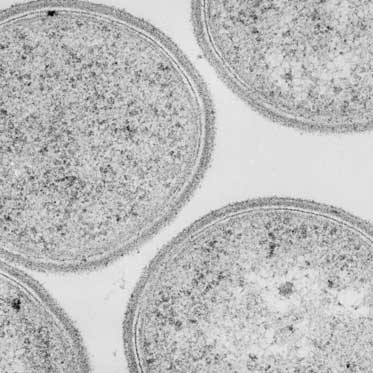Brevibacillus brevis NBRC 100599 (= 47)
Brevibacillus brevis NBRC 100599 (= 47), which was formerly known as Bacillus brevis 47[1], is a strictly aerobic, gram-positive, spore-forming bacterium isolated from soil[2]. B. brevis NBRC 100599 has a characteristic three-layered cell wall composed of a peptidoglycan-layer and the outer two S-layers[3], each consisting of single protein species, and is known to secrete large amounts of proteins into the culture media. The proteins secreted by this strain are mainly derived from the outer two layers of the cell wall, which are shed into the medium with the progress of cell growth[3]. In contrast to its ability of efficient production and secretion of cell wall proteins, this bacterium secretes little protease, which enables easy recovery of the secreted proteins with minimal degradation[4]. Taking advantage of these features, B. brevis NBRC 100599 has been used as a good host for production of heterologous proteins of both prokaryotic and eukaryotic origin[4,5,6].
Sequencing and annotation of the genome of B. brevis NBRC 100599 revealed a single circular chromosome (6,296,436 bp; G+C content of 47.3%) containing 5,950 predicted protein-coding genes, about 30% of which had orthologs in each of the Bacillus genomes. Significant synteny was observed only in the vicinity of the oriC region between B. brevis NBRC 100599 and the Bacillus species. The genome seemed to lack several sugar metabolism genes found in Bacillus subtilis, being in good agreement with the results in other strains showing that B. brevis is unable to utilize L-arabinose, D-mannose and D-xylose[7]. The abundance of genes involved in response to environmental stress, such as those encoding sigma factors and chemotaxis receptors, suggests that this bacterium has a great capacity of adaptation to diverse environments.

References:
- [1] Proposal for two new genera, Brevibacillus gen. nov. and Aneurinibacillus gen. nov.
- Shida O, Takagi H, Kadowaki K and Komagata K. (1997)
Int. J. Syst. Bacteriol. 46:939-46. [PMID:8863420] - [2] Screening for Protein-producing Bacteria.
- Udaka S. (1976)
Agric. Biol. Chem. 40:523-528. - [3] Morphological alterations of cell wall concomitant with protein release in a protein-producing bacterium, Bacillus brevis 47.
- Yamada H, Tsukagoshi N and Udaka S. (1981)
J. Bacteriol. 148:322-32. [PMID:7287624] - [4] Use of Bacillus brevis for efficient synthesis and secretion of human epidermal growth factor.
- Yamagata H, Nakahama K, Suzuki Y, Kakinuma A, Tsukagoshi N and Udaka S. (1988)
Proc. Natl. Acad. Sci. U S A. 86:3589-93. [PMID:2786200] - [5] High-level expression of Bacillus thuringiensis phosphatidylinositol-specific phospholipase C by the Bacillus brevi s host-vector system.
- Kobayashi T, Tamura H, Taguchi R, Udaka S and Ikezawa H. (1996)
Jpn. J. Med. Sci. Biol. 49:103-12. [PMID:8950642] - [6] Secretion of human interleukin-2 in biologically active form by Bacillus brevis directly into culture medium.
- Takimura Y, Kato M, Ohta T, Yamagata H and Udaka S. (1997)
Biosci. Biotechnol. Biochem. 61:1858-61. [PMID:9404065] - [7] Bacillus brevis Migula 1900 taxonomy: reassociation and base composition of DNA.
- Nakamura LK. (1991)
Int. J. Syst. Bacteriol. 41:510-5. [PMID:1742197]
| Genomic size: | 6,296,436 bp |
|---|---|
| The number of ORFs: | 5,949 |
| GC content: | 47.3% |
| Genome Database: | DOGAN |
| NBRC* No. : | 100599 |
- *:
- NBRC is the acronym for "the NITE Biological Resource Center".
The URL of NBRC is http://www.nbrc.nite.go.jp/e/index.html.
- Distribution of Our Microbial Genomic DNAs
- At the Biological Resource Center of the National Institute of Technology and Evaluation (NITE Biological Resource Center, an Incorporated Administrative Agency), we have been distributing the microbial genomic DNA.
Contact us
- Biotechnology Evaluation and Development Division, Biological Resource Center, National Institute of Technology and Evaluation
-
Address:2-49-10 Nishihara, Shibuya-ku, Tokyo 1510066, Japan MAP
Contact Form


